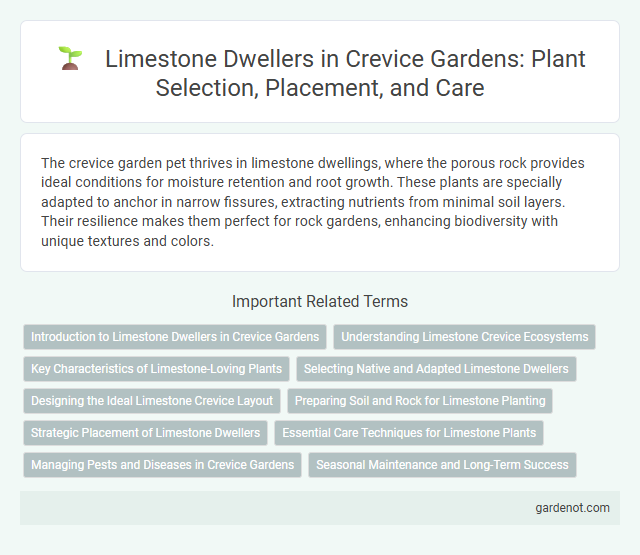The crevice garden pet thrives in limestone dwellings, where the porous rock provides ideal conditions for moisture retention and root growth. These plants are specially adapted to anchor in narrow fissures, extracting nutrients from minimal soil layers. Their resilience makes them perfect for rock gardens, enhancing biodiversity with unique textures and colors.
Introduction to Limestone Dwellers in Crevice Gardens
Limestone dwellers in crevice gardens are specialized plants adapted to thrive in alkaline, well-drained conditions typical of limestone rock formations. These species exhibit remarkable tolerance to nutrient-poor soils and high pH levels, often developing deep root systems that anchor into narrow crevices. Common limestone dwellers include saxifrages, sedums, and campanulas, which contribute to the crevice garden's biodiversity and resilience.
Understanding Limestone Crevice Ecosystems
Limestone crevice ecosystems support unique flora and fauna adapted to high pH, calcium-rich soils and microhabitats with limited moisture. Specialized limestone dwellers, such as calciphilic plants and invertebrates, thrive in narrow rock fissures where nutrient availability and humidity vary significantly. Studying these ecosystems reveals insights into species adaptation, microclimate regulation, and the ecological importance of crevice habitats in biodiversity conservation.
Key Characteristics of Limestone-Loving Plants
Limestone-loving plants thrive in alkaline, calcium-rich soils typical of crevice gardens, exhibiting adaptations such as deep root systems to access moisture within rock fissures and tolerance to high pH levels. These limestone dwellers often have specialized leaf structures that reduce water loss and mineral toxicity, enabling survival in nutrient-poor, rocky environments. Common species include Sedum, dianthus, and certain saxifrages, all displaying drought resistance and slow growth suited to crevice garden habitats.
Selecting Native and Adapted Limestone Dwellers
Selecting native and adapted limestone dwellers ensures optimal growth and survival in crevice gardens by matching plants to the alkaline, well-drained conditions characteristic of limestone substrates. Species such as Arabis alpina, Sedum rupestre, and Dianthus gratianopolitanus thrive in these habitats due to their tolerance for high pH and minimal soil moisture retention. Incorporating these limestone-adapted plants enhances biodiversity while maintaining the structural integrity of crevice gardens.
Designing the Ideal Limestone Crevice Layout
Designing the ideal limestone crevice layout involves strategically placing plants that thrive in alkaline, well-drained conditions such as saxifrages, dianthus, and sedums. Crevices should be narrow and deep to replicate natural fissures, ensuring roots receive adequate moisture without waterlogging. Incorporating varied crevice widths and orientations enhances microclimate diversity, promoting healthy growth for limestone dwellers.
Preparing Soil and Rock for Limestone Planting
Preparing soil for limestone dwellers in a crevice garden requires a well-draining, alkaline substrate rich in calcium carbonate to mimic natural limestone environments. Incorporating crushed limestone or dolomite into the soil enhances pH levels and provides essential minerals, while carefully selecting porous rocks like limestone or sandstone ensures proper root aeration and moisture retention. This combination creates ideal conditions for limestone plants to thrive by replicating their native rocky crevice habitats.
Strategic Placement of Limestone Dwellers
Strategic placement of limestone dwellers in a crevice garden maximizes their natural affinity for alkaline, well-drained conditions typical of limestone substrates. Positioning these plants in crevices with optimal sunlight exposure and protection from excessive moisture mimics their native habitat, promoting healthy growth and vibrant blooms. Careful arrangement ensures efficient use of space, enhances aesthetic appeal, and supports the longevity of limestone-adapted species.
Essential Care Techniques for Limestone Plants
Limestone dwellers, adapted to alkaline, well-drained crevice garden environments, require precise watering to prevent root rot while maintaining consistent soil moisture. Use a gritty, fast-draining soil mix enriched with lime to replicate natural limestone conditions and provide essential minerals. Regular monitoring for sun exposure is critical; these plants thrive in full to partial sunlight to support robust growth and flowering.
Managing Pests and Diseases in Crevice Gardens
Limestone dwellers in crevice gardens require vigilant pest and disease management to maintain their delicate root systems and mineral-rich substrate. Targeted treatments such as organic insecticides and fungicides, combined with proper air circulation and drainage, reduce infestations of aphids, spider mites, and fungal pathogens. Regular inspection and prompt removal of affected foliage ensure the health and longevity of limestone-adapted plants in these specialized rock crevices.
Seasonal Maintenance and Long-Term Success
Limestone dwellers in crevice gardens require seasonal maintenance such as clearing debris and monitoring soil pH to ensure optimal growth. Regular pruning and removal of dead foliage prevent disease and enhance air circulation around root zones. Long-term success depends on balanced watering schedules and occasional soil amendments to sustain their unique calcium-rich habitat.
Limestone dweller Infographic

 gardenot.com
gardenot.com